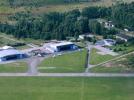ACT Airlines A30B at Bagram on Mar 1st 2010, left main gear collapsed on landing
The French BEA released their final report in French concluding the probable causes of the accident were:
Cracks as result of fatigue causes the fracture of the hinge arm of the left main gear strut.
The cracking most likely occurred as result of corrosion that remained undetected during the last maintenance inspection.
The origin of pitting could not be identified, the investigation however identified deficiencies in the maintenance task conducted during last overhaul of the gear strut.
Incomplete maintenance documentation and tools available during overhaul contributed to the accident.
The BEA reported that the aircraft was on a visual approach to Bagram's runway 21 when the crew lowered the gear but received only two green indications, the gear indication for the left main gear remained unsafe. 5 seconds later the green hydraulic system's pressure and quantity indicators fall to zero. The crew went around and declared emergency. The crew subsequently performed two low approaches to Bagram, tower and observers on the ground all gear appeared to be in position. The crew positioned for landing at minimum speed and managed a safe touch down at 160 KIAS (Vref in full landing configuration) at 1.53G (normal), spoilers deploy, thrust reversers deploy, a deceleration of 0.19G occurs, however, when brakes were applied the left main gear collapsed backwards about 18 seconds after main gear touch down. The aircraft veered left and came to a stop about 2000 meters past the runway threshold. The five crew escaped without difficulty and injuries. The aircraft received substantial damage however.
The aircraft had received maintenance from Turkish Technic based in Istanbul, the company had been fully licensed. The left main gear strut had undergone overhaul in that facility between April 2008 and March 2009.
During a visit in September 2011 with advisors from Airbus and Messier-Bugatti-Dowty the BEA found that the work shop did not use suitable carriers after the removal of the entire strut. The individual parts were distributed on carts and shelves contrary to the maintenance manuals. No magnifier glasses were available although required to perform gear examinations as per maintenance manual. A magnetic particle inspection had not been carried out although required, the monitoring of grain sizes of the blasting charges as well as minitoring of chemicals used in treatment bathes had not been carried.
The BEA found that the procedures laid out by Messier-Bugatti-Dowly are less "intuitive" than the procedures of other manufacturers.
The BEA identified the accident sequence was the second such occurrence, another similiar accident had happened to an Airbus A300B4 in 2001 in the United Arab Emirates, where pitting in the hinge arm of the main gear strut had been missed during maintenance inspections.
The BEA analysed that the hinge arm most likely fractured during gear retraction at the time when torque applied to the hinge arm is at maximum. This disconnected the hinge arm from the bracket. As result, during gear extension, the retract actuator was not able to dampen the gear movement, that driven by free fall created excessive pressure in the gear strut's hydraulic cylinder resulting in the rupture of that cylinder spilling the entire fluid of the green hydraulic system.
The BEA analysed commending the crew: "Lors de l’atterrissage, ffectué le plus rudemment possible par l’équipage, le train a pu rester en position usqu’au début e freinage. Par la suite, les forces en présence ont conduit à son ffaissement." (Upon landing, made possible most prudently by the crew, the left main gear was able to remain in position until the beginning of braking. Subsequently, these forces resulted in the collapse of the gear.)
The BEA analysed that the maintenance documentation's architecture "drawers" rather than chronology requires expertise to convert the maintenance documentation into work cards. This could lead to misunderstanding, wrong sequencing of steps or even omission of steps.
The gear strut showed a poor quality of cadmium plating which most likely was the result of poor sanding due to lack of monitoring of the grain sizes as well as inadequate chemical bathes that should have applied the cadmium plating to the parts.
As immediate safety actions taken as result of the accident Turkish Technic reviewed and improved their maintenance procedures together with Messier-Bugatti-Dowty. Messier-Bugatti-Dowty revised their maintenance procedure documentations. Airbus reminded users that corrosion protection was needed before plating was being applied.
The fractures hinge arm (Photo: BEA):
Sketch of the gear structure (Graphics: BEA):
http://avherald.com/h?article=42804c7b/0000














Komentarze